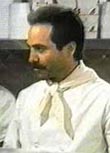|
|
This topic comprises 2 pages: 1 2
|
|
Author
|
Topic: Timing Cinemeccanica Platters/Feed Units
|
Frank Aston
Film Handler

Posts: 54
From: Albrighton, Shropshire, UK
Registered: May 2000
|
 posted 09-07-2002 11:56 AM
posted 09-07-2002 11:56 AM




Could I prevail upon the collective 'brains' of this wonderful forum for a consensus on the most simple method of platter timing?My experience has included use of coins, film loops and complex arrangements with multi-meters as well as counting the rotations of a platter within a given time. News of recent experimentation or the latest thinking would be welcome. "It's always better on the BIG SCREEN". Kind regards, Frank.
| IP: Logged
|
|
|
|
|
|
|
|
Tommie Evans
Expert Film Handler

Posts: 116
From: Birmingham, West Midlands, UK
Registered: Sep 2004
|
 posted 09-11-2004 08:14 AM
posted 09-11-2004 08:14 AM




Timing Cinemeccanica platters <CNR3-35N> here goes....
Speed adjustment of the Pay-out (feed unit)
1: Remove the back cover of the platter tower to gain access to the speed cards.
2: Insert the payout unit into the top platter, move the pay-out control arm to 5-degrees (use a two pence coin placed on top of a ten pence coin) and notice its speed. It is recommended that the platter should just move very slightly.
3: To obtain this setting, loosen the allen screw that locks the speed control arm to the potentiometer spindle, and with the arm still at the 5-degree angle rotate the pot spindle with a small screwdriver or dolby pen until you get the desired setting.
4: Now move the arm to it's 100% or full position, use masking tape to hold it there. The platter should rotate once a second
<tip> To time the platter place several strips of masking tape to the rim of the platter, as the platter spins you can 'hear' the masking tape pass over the motor drive wheel. Use your watch to time the platter. Adjust the trimmer on the card until the desired setting is achieved.
5: Now re-check the speed at the 5-degree setting, adjust the pay-out pot if needed to achieve slight movement.
<for the remaining two platters you do not need to touch the pay-out pot, as it is now set for all three platters>
6: Now place the pay-out unit into the second platter at 100%, adjust the second trimmer to achieve the desired speed.
7: Now do the same for the third and final platter.
NB: the platter system needs to be perfectly level, check it left-to-right / back-to-front with a spirit level.
If the platter is slanted it will throw the print without fail.
Take-up adjustment.
1: Make a loop of film out of 130cm. Place the loop of film on the return arm and the selector rollers of the top platter.
Notice the spped <it should be moving slightly>
2: To adjust the take-up speed remove the platter axel cover and loosen the two small grub screws hold the aluminium block to the pot spindle.
3: Use the potentiometer spindle collar <microswitch actuation collar> to set the trim of the pot to 'slightly moving'
4: retighten the grub screws once you obtain the correct setting.
5: loosen the collar screw <microswitch actuation collar and move it into position so that it presses the failsafe mircoswitch as the very end of the run off the return arm.
<end>
NB: if the collar screw shears off <set to tight at the factory> you will need to rebuild the axel:
start by removing the return arm, spring, connections and axel support completely from the support tower.
Drill or remove the collar and broken screw and remove the variable resistor and replace
Design flaws:
As the film ends and the return arm snaps back it will damage the rubber strip, reverse or replace the rubber strip.
As the film ends and the return arm snaps back it will work the fragile legs of the resistors on the terminal block loose, remove the screw holding the block to the axel support as it will soften the return arm 'spring back' on the resistors.
The brass collar that the variable resistor (50k pot) screws into is crap - if you have to rebuild replace it will a similar component from RS as you get a small nut rather than a weak brass collar. And as for the collar screw never over tighten.
![[Wink]](wink.gif) ![[thumbsup]](graemlins/thumbsup.gif)
| IP: Logged
|
|
|
|
|
|
|
|
|
|
|
|
|
|
|
|
|
|
Antonio Marcheselli
Phenomenal Film Handler

Posts: 1260
From: Florence, Italy
Registered: Mar 2000
|
 posted 10-20-2004 02:42 PM
posted 10-20-2004 02:42 PM





I'm showing my last results so that someone can complete them or can help me.
let's say that the timing issues for CNR platter are three:
1. Have the correct minimum: 5°=stop
2. Have correct Maximum: at maximum the platter should make 60 revolution for seconds. This is very important for correct operation, more important than minimum.
3. Have both payout unit working THE SAME, both at minimum and at Maximum.
I discovered, with the help of one of you, that the trimmer on the control card adjust the "dead" zone of the trimmer of the payout unit.
More the "dead" zone (trimmer on the card clockwise), more the maximum speed, when minimum is set.
Less the "dead" zone (trimmer on the card counterclockwise) and less the maximum speed, when minimum is set.
So I took a payout unit and I set it so that when the minimum is set the platter rotate 60 times per minute (about 180V).
Since often if I take the other payout unit and I set its minimum, its maximum is not correct (with the same control card's setting of the other payout unit), I discovered that the only way to have the payout units work the same is to access the trimmer INSIDE the payout unit and adjust it until the payout units have the same behaviours. This internal trimmer seems to have the same function of the card's trimmer, to raise or lower the "dead" zone, and the maximum speed with it.
But, there is a problem.
When the "dead" zone is reduced (condition for having a reduced speed at maximum), the payout unit is VERY sensible to temperature. So it is not uncommon that the minimum can vary greatly within the day or that the payout unit does nto have a stop position anymore.
But if I raise the "dead" zone I have a minimum more stable but too much maximum speed (up to 230V...).
I'm testing a platter since three weeks, I'm not reach a final solution.
Has anyone have a solution or an idea???
Bye
A
| IP: Logged
|
|
|
|
|
|
All times are Central (GMT -6:00)
|
This topic comprises 2 pages: 1 2
|
Powered by Infopop Corporation
UBB.classicTM
6.3.1.2
The Film-Tech Forums are designed for various members related to the cinema industry to express their opinions, viewpoints and testimonials on various products, services and events based upon speculation, personal knowledge and factual information through use, therefore all views represented here allow no liability upon the publishers of this web site and the owners of said views assume no liability for any ill will resulting from these postings. The posts made here are for educational as well as entertainment purposes and as such anyone viewing this portion of the website must accept these views as statements of the author of that opinion
and agrees to release the authors from any and all liability.
|

 Home
Home
 Products
Products
 Store
Store
 Forum
Forum
 Warehouse
Warehouse
 Contact Us
Contact Us




 Printer-friendly view of this topic
Printer-friendly view of this topic









![[Wink]](wink.gif)
![[thumbsup]](graemlins/thumbsup.gif)

![[Big Grin]](biggrin.gif)
![[Eek!]](eek.gif)
![[Smile]](smile.gif) )
)



